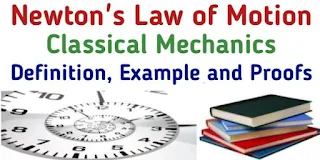Newton's Laws of Motion | Definitions, Examples and Proofs
Newton's Law of Motion
Sir Isaac Newton expressed his ideas regarding the motion of a bodies in the form of three laws which are considered as the basic laws of mechanics. In fact mechanics is a study of certain general relations that describe the interactions of material bodies. One general property of a material body is inertial mass and other is force to describe the movement of bodies.
There are three laws of motion of Newton which are explained below in detail :
(i) Law of inertia (First Law)
According to this law, "A body continuous in its state of rest or constant velocity unless it is disturbed by external influence". This property of body to being continue in its original state of motions and not changing the state is called Inertia and the external influence is called force.
Example of Inertia
When a stopped vehicle suddenly moves, the passengers sitting in it lean backwards.
When a moving vehicle suddenly stops, the passengers sitting in it lean forwards.
By shaking the branches of the tree, the fruit breaks and falls down.
To tighten the hammer, we hit the handle of hammer on the ground.
(ii) Law of Force (Second Law)
According to this law, "The rate of change of momentum of a body is directly proportional to the applied force on the body", i.e.,
F ∞ dP/dt , F = dP/dt
The momentum of a body is defined as,
P = mv
Therefore, F = d(mv)/dt
F = mdv/dt
F = ma
In fact, 1st law is a special case of 2nd law, because If force is not acting on a body, i.e. the force is absent for a body, f = 0, then dv/dt = 0 and therefore v = constant, so body continues in its original motion.
Examples of second Law of motion
The cricket player moves his hands in the direction of the velocity of ball while catching the ball coming fast so that the injury is minimized.
When, we fall on the mattress or mud floor, then we injured less than we fall on the cement floor.
Spring and Shock absorbers are applied to the vehicles so that the injury will be minimized.
High jump and long jump are made by digging the soil of the field to make it less hurt to jump.
(iii) Law of Action and reaction (Third Law)
According to this law, "To every action there is always equal and opposite reaction".
Let two bodies 1 & 2 are interaction together, then
F12 = -F21
(force on body 2 by 1) = -(force on body 1 by 2)
If masses of both bodies be m1 & m2 then
m1(dv1/dt) = m2(dv2/dt)
If the ratio of accelerations of two interacting bodies is determined then their mass ratio will be determined. If one is standard (1kg) then mass of the other body can be calculated,
m2 = m1a1/a2
m2/m1 = a1/a2
This means that if an isolated system of two bodies is interacting among the stylemselves, then by measuring their accelerations the ratio of their masses can be determined.
Examples of Third Law of Motion
Jerking backwards while dropping a bullet from a gun.
A person falls behind when a rope breaks while drawing water from the well.
Pressing the ground by the stick to move a Ship.
Moving backward of a ship while jumping a person from the ship to the ground.


